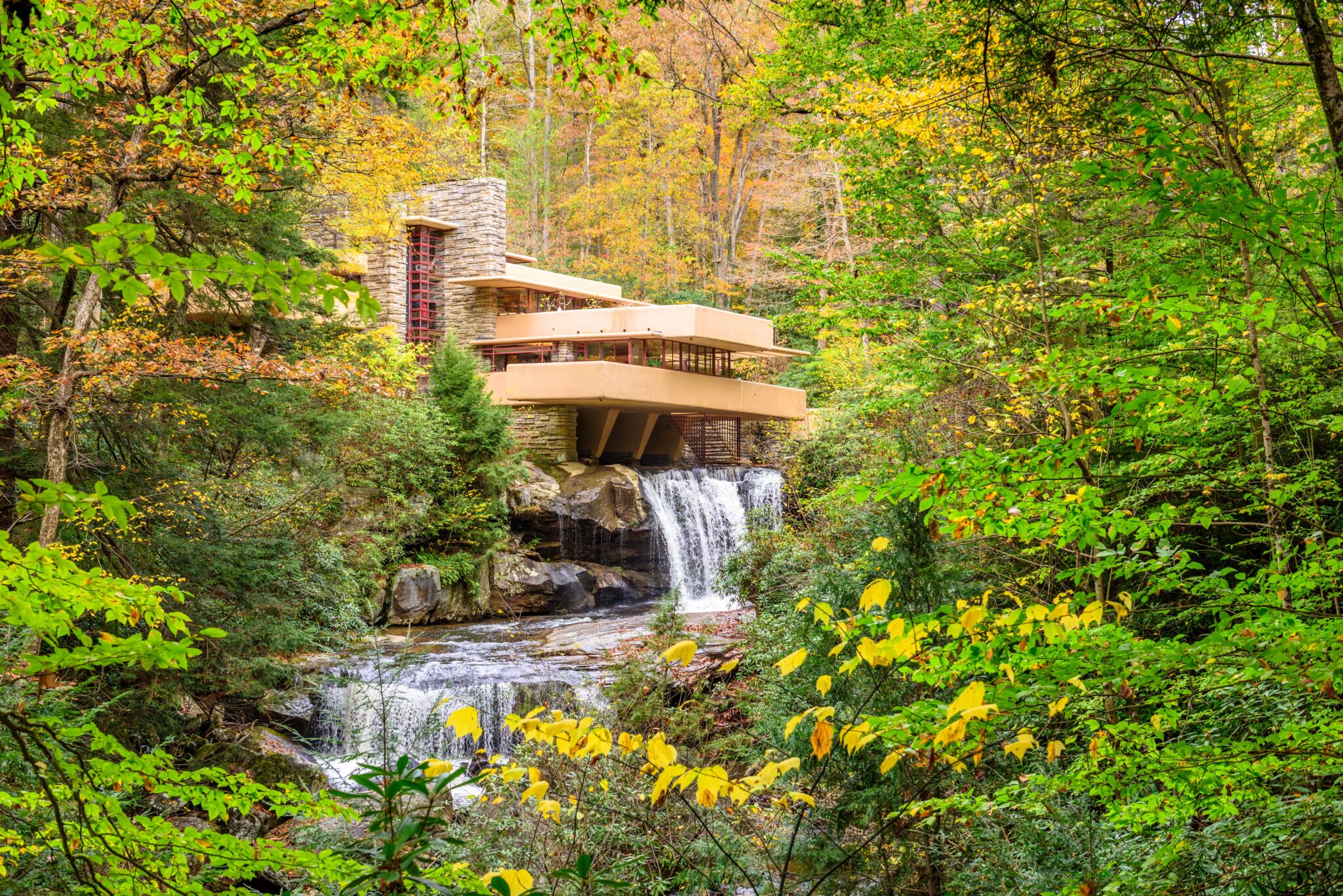If you ask an American – or an architecture aficionado from elsewhere in the world – who is the most iconic American architect? The answer will nearly always be Frank Lloyd Wright. And his fame is warranted. Not only did he design some of the most beautiful and innovative buildings and homes in the world, but he also changed the way we build and live. But how much do those asked the question know about Wright? How much do you?
Early life
Wright, born in Richland Center, Wisconsin in 1867, lived in many different parts of the United States. Growing up as the son of a nomadic minister, the family traveled from one ministry position to another and young Frank lived in Rhode Island, Iowa, and Massachusetts. The different architectural styles and spaces surely impacted his young mind.
Impacting Wright’s future career was the divorce of his parents in 1885. To help the family’s financial circumstances, the 18-year-old Frank Lloyd Wright worked for the dean of the University of Wisconsin’s department of engineering. Although he began studying engineering, he decided early on that his interest was in architecture. In 1887, he left Madison for Chicago, where he found work with two different firms before being hired by the prestigious partnership of Adler and Sullivan, working directly under Louis Sullivan for six years. He was able to pair his life experiences with his academic engineering experience and, as they say, the rest is history.


So, It Begins
In 1889, at age 22, Wright married Catherine Tobin. Eager to build his own home, he negotiated a five-year contract with Sullivan in exchange for a loan to purchase land. Which he did – a wooded corner lot in the Chicago suburb of Oak Park. It is here that Frank Lloyd Wright built his first house. The home was small and reminiscent of the East Coast shingle style with its prominent roof gable. It reflected Wright’s ingenuity as he experimented with geometric shapes in the later added studio and playroom. (He had six children.)
Wright’s home was filled with beautiful things and exquisite interior design and before long, Wright’s escalating expenses required him to accept independent residential commissions. Although he did these on his own time, when Sullivan became aware of them in 1893, he charged Wright with breach of contract. It is not clear whether Wright quit or was fired, but his departure was acrimonious, creating a rift between the two men that was not repaired for nearly two decades. The split, however, presented the opportunity Wright needed to go out on his own. He opened an office and began his quest to design homes that he believed would truly belong on the American prairie.
The First of Many
Wright went to work and received his first independent commission, which was to build the William H. Winslow House. While conservative in comparison to work of a few years later, with its broad sheltering roof and simple elegance, it nonetheless attracted local attention.
Determined to create indigenous American architecture, over the next sixteen years, Wright set the standards for what became known as the Prairie Style. These houses reflected the long, low horizontal prairie on which they sat with low-pitched roofs, deep overhangs, no attics or basements, and generally long rows of casement windows that further emphasized the horizontal theme. Some of Wright’s most important residential works of the time are the Darwin D. Martin House in Buffalo, New York (1903), the Avery Coonley House in Riverside, Illinois (1907), and the Frederick C. Robie House in Chicago (1908). Important public commissions included the Larkin Company Administration Building in Buffalo (1903, demolished 1950) and Unity Temple in Oak Park (1905).

Wright Grows Restless
In 1909, Wright left his family for an extended stay in Europe with Mamah Borthwick (a client with whom he was in love and would subsequently have an affair) hoping that he could release the discontent he felt in both his professional and domestic lives. During this time, Wright worked on two publications of his work. But while in Europe, Wright’s drawings and photographs were published which brought him international recognition.
Wright and Borthwick returned to the United States. Unwelcome in Chicago social circles, they moved to Taliesin near Spring Green, and Wright began construction on a new home that would become their refuge. There he also resumed his architectural practice and over the next several years received two important public commissions: the first in 1913 for an entertainment center called Midway Gardens in Chicago; the second, in 1916, for the new Imperial Hotel in Tokyo, Japan.
In August 1914, Wright’s life with Mamah was tragically closed as she, her two children and four others were killed in a brutal attack and fire, intentionally started by an angry domestic employee. Devastated, Wright was only able to find solace in work as he began to rebuild Taliesin in Mamah’s memory. Once completed, he then effectively abandoned it for nearly a decade as he pursued major work in Tokyo with the Imperial Hotel and Los Angeles with the Hollyhock House and Olive Hill for oil heiress Aline Barnsdall.
The Aftermath
Although the years between 1922 and 1934 were architecturally creative, they were also financially disastrous. (Wright’s first wife granted him a divorce in 1922. He then married Miriam Noel in 1923. Their divorce was finalized in 1927.) Wright had established an office in Los Angeles, but following his return from Japan in 1922 commissions were scarce. The only exception was that of four textile block houses of 1923–1924 (Millard, Storer, Freeman and Ennis). He abandoned the West Coast and returned to Taliesin.
Only a few projects went into construction, and it was a decade of unfinished works. Among the unbuilt commissions were the National Life Insurance Building (Chicago, 1924), the Gordon Strong Automobile Objective (Sugarloaf Mountain, Maryland, 1925), San Marcos-in-the-Desert resort (Chandler, Arizona, 1928), and St. Mark’s-in-the-Bouwerie apartment towers (New York City, 1928).
Near the end of the Roaring Twenties – in 1928 — Wright married Olga Lazovich, daughter of a Chief Justice of Montenegro, whom he had met a few years earlier in Chicago. She proved to be the partner and stabilizing influence he needed to refocus on “the cause of architecture” he had begun decades earlier.
With few architectural commissions coming his way, Wright turned to writing and lecturing which introduced him to a larger national audience. Two important publications came out in 1932: An Autobiography and The Disappearing City. The first received widespread critical acclaim and would continue to inspire generations of young architects. The second introduced Wright’s scheme for Broadacre City, a utopian vision for decentralization that moved the city into the country. Although it received little serious consideration at the time, it would influence community development in unforeseen ways in the decades to come. At about this same time, Wright and Olga founded an architectural school at Taliesin, the “Taliesin Fellowship,” an apprenticeship program to provide a total learning environment, integrating not only architecture and construction, but also farming, gardening, and cooking, and the study of nature, music, art, and dance.
Later Life
During the winter of 1934, Wright rented a property in the warmer air of Arizona and worked on the Broadacre City model, which would debut in Rockefeller Center in 1935. By this time, Wright was still considered a great architect, but one whose time had come and gone. In 1936, Wright proved this sentiment wrong as he staged a remarkable comeback with several important commissions including the S.C. Johnson and Son Company Administration Building in Racine, Wisconsin; Fallingwater, the country house for Edgar Kaufmann in rural Pennsylvania; and the Herbert Jacobs House (the first executed “Usonian” house) in Madison.
At this same time, Wright decided he wanted a more permanent winter residence in Arizona, and he acquired some acreage of raw, rugged desert in the foothills of the McDowell Mountains in Scottsdale. Here he and the Taliesin Fellowship began the construction of Taliesin West as a winter camp, a bold new endeavor for desert living where he tested design innovations, structural ideas, and building details that responded to the dramatic desert setting. Wright and the fellowship established migration patterns between Wisconsin and Arizona, which the Frank Lloyd Wright School of Architecture continues to this day.
Acknowledging Wright’s stunning reentry into the architectural spotlight, the Museum of Modern Art in New York staged a comprehensive retrospective exhibition that opened in 1940. In June 1943, undeterred by a world at war, Wright received a letter that initiated the most important, and most challenging, commission of his late career. Baroness Hilla von Rebay wrote asking him to design a building to house the Solomon R. Guggenheim collection of non-objective paintings. Wright responded enthusiastically, never anticipating the tremendous amount of time and energy this project would consume before its completion sixteen years later.


The End
With the end of World War II, apprentices returned and work again flowed into Wright’s studio. Completed public projects over the next decade included the Research Tower for the SC Johnson Company, a Unitarian meeting house in Madison, a skyscraper in Oklahoma, and several buildings for Florida Southern College.
Wright opened his last decade with work on a large exhibition, Frank Lloyd Wright: Sixty Years of Living Architecture, which was soon on an international tour traveling to Florence, Paris, Zurich, Munich, Rotterdam, and Mexico City, before returning to the United States for additional venues. Impressively energetic for a man in his eighties, he continued to travel extensively, lecture widely, and write prolifically. He was still actively involved with all aspects of work including frequent trips to New York to oversee the construction of the Guggenheim Museum when, in April of 1959, he was suddenly stricken by an illness that forced his hospitalization. He died on April 9, two months shy of his ninety-second birthday.
But Not the End of His Style and Design
Frank Lloyd Wright developed two styles that changed the course of architectural history and to this day impact the architectural world.
The “Prairie Style” (1899-1910 development) showcases a long, low, open-plan structure that eschewed the typical high, straight-sided box. It emphasizes the horizontal line of the prairie and domesticity and was established as the first truly American architecture. In a Prairie house, “the essential nature of the box could be eliminated,” Wright explained. Interior walls were minimized to emphasize openness and community.
Responding to the financial crisis of 1929 and the ensuing Great Depression that gripped the United States and the rest of the world, Wright began working on affordable housing, which developed into the Usonian house. Wright’s Usonians were a simplified approach to residential construction that reflected both economic realities and changing social trends. In the Usonian houses, Wright was offering a simplified, but beautiful environment for living that Americans could both afford and enjoy. Wright would continue to design Usonian houses for the rest of his career, with variations reflecting diverse client budgets.
Wright Principles
Wright aspired to provide his client with environments that were not only functional but also “eloquent and humane.” Perhaps uniquely among the great architects, Wright pursued architecture for every man rather than every man for one architecture through the careful use of standardization to achieve accessible tailoring options for his clients.
Believing that architecture could be genuinely transformative, he devoted his life to creating a total aesthetic that would enhance society’s well-being. “Above all integrity,” he would say, “buildings like people must first be sincere, must be true.” Architecture was not just about buildings, but about nourishing the lives of those within them.
For Wright, a truly organic building developed from within outwards and was thus in harmony with its time, place, and inhabitants. “In organic architecture then, it is quite impossible to consider the building as one thing, its furnishings another, and its setting and environment still another,” he concluded. “The spirit in which these buildings are conceived sees all these together at work as one thing.” To that end, Wright designed furniture, rugs, fabrics, art glass, lighting, dinnerware, and graphic arts.
Frank Lloyd Wright embraced new technologies and tactics, constantly pushing the boundaries of his field. His fascination for the new and his desire to be a pioneer help explain Wright’s tendency to test his materials—sometimes even to the brink of failure—in an effort to achieve effects he could claim as uniquely his own.
Wright devoted his life to promoting architecture as “the great mother art, behind which all others are definitely, distinctly and inevitably related.” Seeking a consistent expression of underlying unity, he drew inspiration from the Japanese idea of a culture in which every object, every human, and every action were integrated so as to make an entire civilization a work of art. Above all else, Wright’s vision served beauty. He believed that every man, woman and child had the right to live a beautiful life in beautiful circumstances and he sought to create an affordable architecture that served that aspiration.
Designing 1,114 architectural works of all types — 532 of which were realized — he created some of the most innovative spaces in the world. With a career that spanned seven decades before his death in 1959, Wright’s visionary work cemented his place as the American Institute of Architects’ “greatest American architect of all time.”




